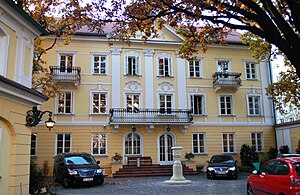Sugar Factory Palace
| Sugar Factory Palace | ||
|---|---|---|
|
The facade of the three-story palace with a large balcony on the first floor, pilasters and a triangular pediment |
||
| Creation time : | 1922 | |
| Castle type : | palace | |
| Conservation status: | Reconstructed | |
| Place: | Warsaw | |
| Geographical location | 52 ° 13 '16 " N , 21 ° 1' 5.5" E | |
|
|
||
The Sugar Factory Palace (also: Palace of the Lublin Sugar Factory Association , Polish: Pałacyk Cukrowników or Pałacyk Zarządu Spółek Cukrowni Lubelskich ) is located in the southern part of Warsaw's inner city district on 25 Mokotowska Street near Plac Zbawiciela . Today the Adam Mickiewicz Institute is located here . The small palace ensemble is a listed building.
history
The history of the palace's origins is disputed. Originally there was a manor of the Kaczyński family here. In 1907 Jan Kaczyński took over the property, on which he built a new building around 1915 or expanded the existing property. Mieczysław Kaczyński later ran a printing company on the premises with his business partner Wacław Cywiński. In 1922, the Lublin Sugar Factory Association (Polish: Związek Cukrowni Lubelskiej ) called "Celin" (including member factories in Zbiersk, Garbów, Lublin and Nielepów) acquired the property. In the following year, the building was rebuilt under the direction of Tadeusz Zieliński and a side wing was added. In addition to the sugar producers, other companies from the Lublin area were also represented in the new palace, which is now in the Neo- Rococo style.
In 1935 Mieczysław Broniewski bought the property. The board of directors of the sugar company moved to a building at 8 Koszykowa Street . Broniewski had the palace renovated and redesigned by Antoni Jawornicki. A small statue of a reclining Cupid was attached to the roof of each of the two outbuildings ( facing Mokotowska Street ) ; the left surrounded by hares, the right by two calves. Under Broniewski, the palace was furnished with valuable works of art.
During the German occupation , an office for the sugar industry worked in the palace. Broniewski's mother, Eugenia, was probably also living in part of the building at the time. The son wanted by the Gestapo had fled abroad and did not return to Warsaw until 1947. The palace was not significantly damaged in the war. After the war, the Central Training Center of the PZPR (Polish: Centralny Ośrodek Szkolenia Partyjnego PZPR ) and later the International Center for Mathematics "Stefan Banach" (Polish: Międzynarodowe Centrum Matematyczne im. Stefana Banacha ) was located here.
In 1987 the building was completely renovated. In 2000 the property was returned to a Broniewski heir. He sold the palace to the Adam Minkiewicz Institute (Polish: Instytut Adama Mickiewicza ). In October 2010 a plaque was placed on the building in memory of the founders of the institute, Bronisław Feremka and Andrzej Zakrzewski.
See also
Web links
- To the palace in Warszawikia (Polish)
- Brief information and a historical view at Warszawa1939.pl (Polish)
- Detailed article at Klimat Warszawy (Polish)
literature
- Julius A. Chroscicki and Andrzej Rottermund, Architectural Atlas of Warsaw , 1st edition, Arkady, Warsaw 1978, p. 172



